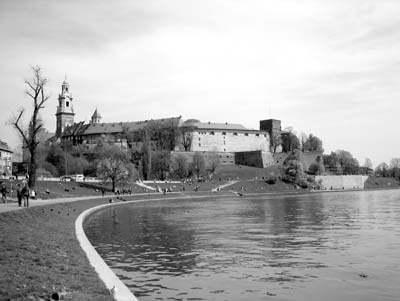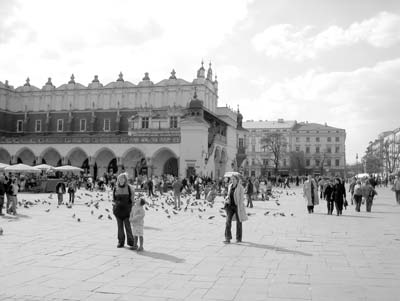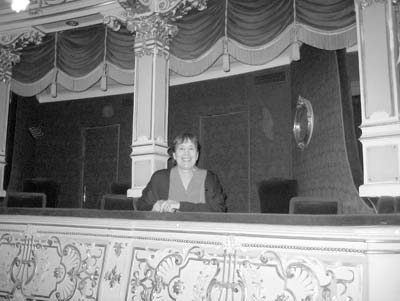Kraków
Kraków, Poland, is a small city. The Old Town — encompassing the town square, the old city walls, the opera house, museums and churches — is less than a square kilometer. The castle, called the Wawel, is a kilometer from the town square. Kazimierz, the old Jewish quarter, is a 15-minute walk beyond the castle.
Old Town’s town square has a lovely market square built in the Middle Ages. In its center is the Cloth Hall, a long, Renaissance-period building which today houses crafts and souvenir stands on the ground floor and a museum on the second level. During a visit my husband, Jerry, and I made, April 22-25, 2005, the square was also full of wonderful flower stalls.
Near the flower stalls we found the imposing St. Mary’s Church. It has two towers that are different in height. On the hour, a trumpeter plays an ancient tune from the days before the Tartar invasion (1241). This was the tune that was played to warn the town of invaders. When the Tartar invasion took place, the trumpeter was killed mid-song. Today the music ends abruptly at that point.
St. Mary’s Church is lovely and has an amazing altar. Just as we were standing in the aisle looking at the altar, the organ started up. We turned around and a bride was coming in with her father.
Just a stone’s throw from Market Square is the Czartoryski Museum. The building is lovely and spans two streets, with a beautiful walkway above the streets — something like the Bridge of Sighs in Venice. The museum is small but has some wonderful paintings, including Da Vinci’s exquisite “Lady with an Ermine.”
Right next to the museum are the old city walls that date back to the 1200s. Only one section is preserved, but it is just beautiful. Artists set up to sell their paintings by the wall.
The town square is lined with restaurants with outdoor seating (in fine weather). We were lucky to be in Kraków for a sunny Saturday and Sunday. The square was full of people eating, playing musical instruments or just milling around. We bought cheese, pretzels and ice cream from street vendors. The cheese was a baked cheese (a little goes a long way).
The Wawel was the old fortress and palace of the Polish kings for 500 years. Like most fortresses, it stands up on the hill overlooking the town and the river. The most impressive approach is from the river. The State Rooms and the Private Rooms require timed tickets. The Private Room tickets are limited, so go early.
The State Rooms were interesting, but the Private Rooms were fantastic. Only some of the furniture has survived (the Austrian army used the palace as a headquarters for about 100 years), but the fireplaces and chimneys and the carvings on the walls are fabulous. Best are the tapestries. Of the original hundreds, enough survived to be impressive. They are exquisite.
Before WWII, more than a quarter of Kraków’s population was Jewish, with 60,000 Jews living in Kazimierz. Today there are only about 100 Jews living in all of Kraków. We went into two synagogues: the Tempel, with carved wooden seats and lovely decorations, and the Issac Synagogue with its stucco walls with blessings. Both are only museums today.
The old square in Kazimierz is charming and has a number of Jewish restaurants that provide klezmer music in the evening. We were unable to get reservations as the restaurants all were full.
We had a unique experience in Kazimierz. Our second evening in Kraków was the first night of Passover. We saw an announcement that the Galicia Jewish Museum was holding a Seder at the museum, so we signed up. It was a wonderful evening.
The 40 of us were a mixture of locals and tourists. The main languages spoken and used in the reading of the Hagadah (the book for the Seder) were English, Hebrew and Polish. The ritual foods varied a bit from my tradition. The “green” was a potato, the soup was egg-and-potato soup, dessert was a chocolate-covered banana and the main course was missing. The spirit of the evening, the songs and the laughter were fantastic.
We attended an excellent performance of the opera “Barber of Seville” with Polish subtitles. We had fabulous seats that cost about $17 each. The Kraków Opera House is absolutely delicious — like a wedding cake. It is a small replica (700 seats) of the Paris Opera House but, I believe, even more beautiful. The painted curtain, the chandelier and ceilings are magnificent.
On the second floor is a large room for people to congregate during the intermission. It is sumptuous with red velvet chairs and a lovely chandelier. The audience was allowed to bring the champagne (served in real glasses) back to the seats. The only drawback to the house were the restrooms. There was one stall on each level for each sex. The lines were ridiculous.
We chose our hotel, the Radisson SAS Hotel Krakow, for its location on Straszewskiego Street between the square and the castle. The rack rate was €145 (in 2007, €170). Although it’s primarily a business hotel, the desk staff was amazingly helpful. The breakfasts, included in the rate, were wonderful.
We found Kraków to be a delight and highly recommend it.
NILI OLAY
New York, NY



